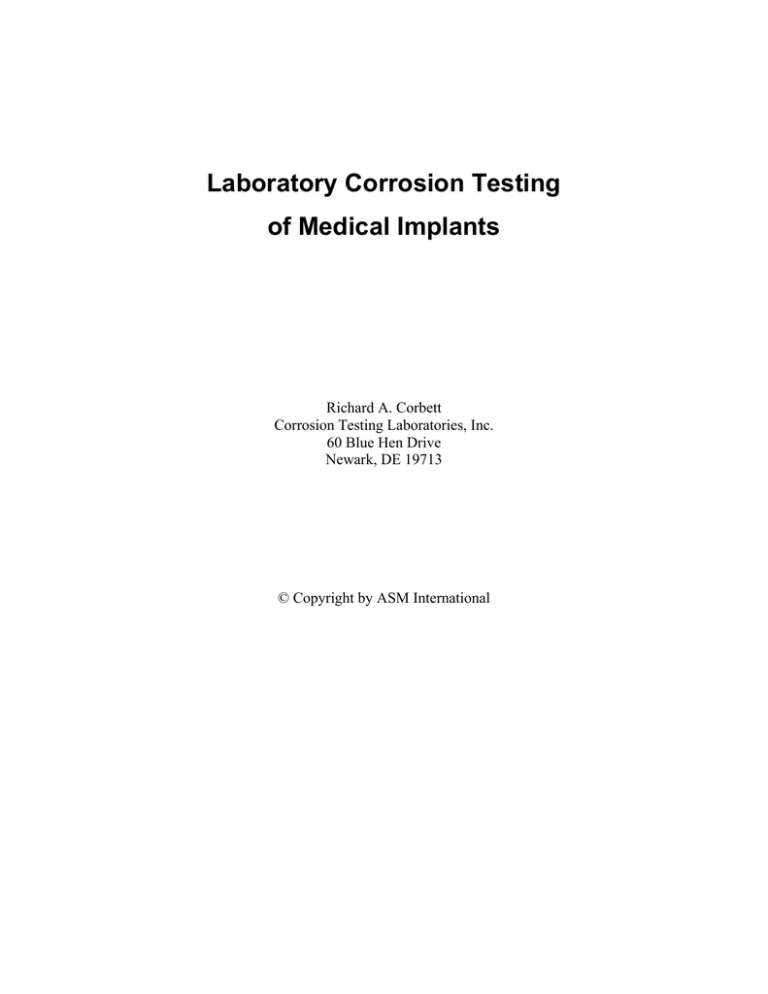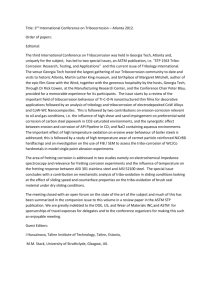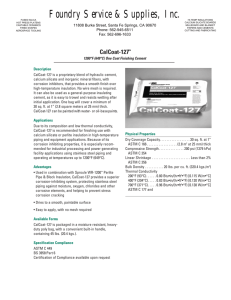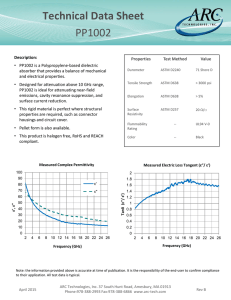Laboratory Corrosion Testing of Medical Implants
advertisement

Laboratory Corrosion Testing of Medical Implants Richard A. Corbett Corrosion Testing Laboratories, Inc. 60 Blue Hen Drive Newark, DE 19713 © Copyright by ASM International Laboratory Corrosion Testing of Medical Implants Richard A. Corbett Corrosion Testing Laboratories, Inc., Newark, Delaware, USA Abstract Performance evaluation of implantable devices is not new to medical device manufacturers, specifically implant manufacturers. A focus on corrosion resistance of implant devices has prompted members of the medical device industry, along with the United States Food and Drug Administration [USFDA] to set forth a guide for performance testing. Although actual corrosion resistance of a material can only be proven through long-term clinical trials, accelerated laboratory tests can be used to predict certain effects. Because corrosion of metals is an electrochemical process, accepted electrochemical testing techniques are used very effectively in the CPI (Chemical Process Industry) [namely ASTM G5, G61, and G71] have been adopted for use. Inconsistencies among laboratories, employing differing protocols, have resulted in varying interpretations by even the most experienced electrochemists and corrosion scientists. Some of the most widely used standard tests are also the most widely abused and misinterpreted, especially by persons who are less aware of materials properties. Since the USFDA provides no clear direction to testing, a modified electrochemical standard [ASTM F2129] has been adopted to address concerns regarding test environment, voltage scan rate, device configuration, and test protocol. The remaining issue is the establishment of an acceptance criterion. Introduction Implantable metal devices to treat diseases and repair the human body have been used for centuries. A gold plate was used to repair a cleft palate in 1546. In the 1600’s, iron, bronze and gold wire were used for sutures.1 During the twentieth century Type 316 stainless steel was widely used as a prosthetic metal, and in recent years, the high-strength alloy MP35N,2 and the shape-memory alloy “Nitinol” have been used in implantable device applications. 3 The most important requirement for an implantable material is that it must have corrosion resistance to physiological environments. All metallic implantable alloys are susceptible to corrosion to a certain degree, depending on the metallurgical condition, residual or service stresses, thermal history, and final surface treatment applied prior to implantation. It is the intent of this paper to prove our experience in the development and refining of laboratory tests to assist medical implant device manufacturers in evaluating their products for acceptance as being in the optimal corrosion resistant condition. There are a number of test tools available in achieving this goal. No one test is sufficient to provide all of the answers. Background Corrosion is defined as the deterioration of a material when exposed to an environment. For metals, this deterioration is an electrochemical process wherein a positive ion of the metal is released from the metal surface [identified as the anode] into the environment and subsequently an electron is released into the metal, where it combines with a positive dissolved ion [identified as the cathode]. Because of the flow of electrons [termed current] this process is an electrochemical reaction, and subsequently, electrical instruments, such as voltmeters and ammeters, can monitor this reaction. A metal achieves corrosion resistance by forming a protective oxide layer over its surface, somewhat akin to a barrier coating. This is termed “passivation” and is not synonymous with cleanliness. Cleaning a stainless steel in citric acid removes ferrous and ferric oxides but it does not passivate the surface, however exposing the stainless steel to nitric acid will rapidly form a protective chromium oxide layer that is passive.4 This is addressed in ASTM F 86.55 Testing a device to ASTM B 1176 will evaluate the presence of iron oxides and degree of cleanliness, but it will not determine the alloy’s corrosion resistance. Development of ASTM Standards ASTM G 317 is an immersion test procedure that typically requires extended exposure periods, up to years, to evaluate the resistance of materials, which are employed in the implant device industry, to corrosion. As such, accelerating the testing by inducing changes on the material and monitoring the results has been an industry-accepted method. The development of accelerated electrochemical tests to study corrosion began in earnest during the late 1960’s and into the 1980’s in the CPI. The original test standard, ASTM G 5,8 was expanded from a stepped potentiostatic test to a potentiodynamic test as electronics developed, and subsequently to a cyclic experiment to examine susceptibility to localized pitting and crevice corrosion [ASTM G 619]. Galvanic studies between mixed metals in contact with each other were evaluated using the established ASTM G 7110. During the late 1970’s it was recognized that implantable alloys should not only be generally resistant to corrosion but also resistant to localized pitting and crevice attack. Research performed by Syrett11 at the Stanford Research Institute identified a method of assessing the pitting resistance of alloys using passive-pitting-repassivation (PPR) curves. This method was modified by members of ASTM Subcommittee F04.02 to create the ASTM Standard F 746.12 This test was designed to determine an inter-laboratory ranking of alloys, and not devices, to increasing resistance to pitting and crevice corrosion under specific conditions. The test conditions were intentionally designed to cause breakdown of Type 316L stainless steel, then considered acceptable for surgical implant use. The test results realized that those alloys that suffered localized attack during the test do not necessarily undergo localized corrosion when placed in the human body as an implant. The test consisted of placing a nonmetallic collar around a test specimen that was immersed in a 0.9% sodium chloride solution for one hour while measuring the potential (E1) with respect to a saturated calomel electrode (SCE). After one hour, the potential of the specimen was shifted to +0.8 V (SCE) and held there for a specific period of time. Depending on the resulting current change over the course of time the resistance to localized attack could be assessed. Then the potential was shifted back to the one hour potential E1, and the current recorded for an additional period of time to determine the state of repassivation. The forming, shaping and finishing steps, including heat treatments, used in the manufacturing of implant devices can significantly alter the corrosion resistance of the alloy from which the device was fabricated. During the selection of a material for use as an implantable device, certain tests, such as F 746, G 5, and G61, can identify corrosion resistance but this does not ensure that actual performance has not been modified because of component fabrication or assembly. Because corrosion of implant devices would have detrimental effects on their performance, it was necessary to determine their susceptibility to localized attack. Originally, ASTM G 61 was used by many to assess the susceptibility of localized corrosion, but this standard was too broad and the interpretation of repassivation was not addressed. Therefore, during the late 1990’s draft revisions and modifications were made to this standard. Thus, the ASTM Committee F04 on Medical and Surgical Materials and Devices adopted F 212913 as a modification of the ASTM Standard G 61. This standard assessed the corrosion resistance of small metallic devices or components using the G 61 technique but specific to implants. The devices, anticipated to be evaluated by this test method, included vascular stents, filters, support segments of endovascular grafts, cardiac occluders, aneurysm or ligation clips, staples, etc. The test specimens were to represent the device in its final form and finish, as it would be implanted, and they would be tested in their entirety. Summarizing the F 2129 test method, the device is immersed in a deaerated simulated physiological solution and the open circuit (rest) potential [Er] is measured for one hour. Then potentiodynamic polarization scan is made from an initial potential of negative 100 mV from the one hour potential. The scan is in the positive, active to noble, direction at a rate of 0.16 mV per second. The scan is reversed when the current has reached two decades greater than that of the breakdown potential [Eb] (defined as a rapid increase of current per increment of applied potential). The reverse scan is stopped when the current becomes less than the current in the forward scan (defined as the protection potential, Ep) or the potential reaches the initial potential. The data is plotted on an x-y semi logarithmic diagram with the current density on the x-axis [logarithmic] in mA/cm2 and the potential versus a SCE on the linear y-axis. Appropriate references in their final form and finish are used as controls. Limitations on testing Nitrogen High purity nitrogen gas for purging was recommended in the original F 2129 standard although no purity specifications were given. In order to tighten the standard, maximum purities were specified in the current revision, such as 99.999% bottled gas or the vent gas coming from a Dewar of liquefied nitrogen, which serves the same purpose. Test solution The original F 2129 standard was non-mandatory in the selection of a test solution, although several different physiological environments were referenced. Phosphate buffered saline [PBS] was always our recommendation to clients who asked for our opinion. However, this was before the issuance of F 2129 in September 2001 when that document purposely excluded PBS. Since then, we have tested devices in Ringers and Hanks solutions. One of our major clients mandated that we use Hanks solution until it was discovered that the pH of the solution changed dramatically [pH 7.4 at the beginning of the test to pH 8.5 upon completion, Fig. 1]. Upon further investigation, it was discovered that calcium and magnesium precipitates covered the test cell as well as the test specimen (Figs. 2a and b, spectrographic analysis, EDS). energy dispersive x-ray 9.5 Specimen holders Making an attachment to the device so as to minimize a crevice situation or to prevent a galvanic couple between mixed metals is always a challenge. The F 2129 standard states that wire or coil specimens can be mounted to the G 5 holder clamped between stainless steel nuts and partly immersed so as not to expose the hardware in the solution. This exposes the specimen to the air-liquid interface, which subjects it to localized crevice corrosion. An alternative is to coat the specimen at this interface; however, the coated area that is below the solution surface will also introduce a crevice. 9 8.5 pH 8 7.5 7 6.5 6 Hanks Ringers PBS Figure 1: Effect of deaeration with nitrogen on the pH of Hanks, Ringers and phosphate buffered solutions (a) For stents or cylindrical devices, the F 2129 standard recommends using a special fixture consisting of a cylindrical mandrel that can accommodate the specimen holder described in G 5. The limitation of this device is coating the whole thing with a non-conductive resin, wherein any pinhole in the coating would lead to galvanic corrosion. Since it appears that no holder will completely eliminate crevices or a susceptibility to galvanic coupling, there has been success from using precision mini-clip test jumpers [RadioShack part number 278-016A]. These mini-clips are useful for small staples, laser cut tube, and wire mesh devices. The clips fit neatly into the glass electrode holder described in G 5. The clip provides a small contact point that minimizes coating area and galvanic exposure. Acceptance criteria An acceptance criterion is not addressed in any of the standards. Even the FDA does not specify a breakdown potential that must be met to consider a device acceptable. The burden is on the device manufacturer to justify the results they submit in their document package. (b) Figure 2a and b: (a) Clean platinum wire before exposure to Hanks solution: (b) after F 2129 polarization scan at 37°C. Note the presence of calcium, magnesium, oxygen, and increased carbon, indicative of carbonate precipitation In the current re-balloting of F 2129, PBS is the preferred test solution, although other physiological environments are listed as alternatives, including Ringers and Hanks. After evaluating several hundred devices as a third party laboratory, we have developed opinions as to what breakdown potentials should be acceptable, what are unacceptable, and what are marginal. It is our opinion that if a breakdown potential exceeds +600 mV [SCE] in PBS at 37°C, then the alloy is in its optimum corrosion resistant condition. If the breakdown potential is more electronegative than +300 mV, then the alloy is not in an optimal corrosion resistant condition. At breakdown potentials between +300 and +600 mV the alloy is marginal, and a high confidence level [i.e., a larger number of replicates] is needed for acceptance that the alloy will exhibit stable passive behavior. Replicates Electrochemical testing is dependant on the interaction between a metal and the environment. Subtle changes in either will result in minor or major shifts in the current densities when running a potential scan. This is nowhere better brought out than in the scatter bands depicted in G 5. Therefore, to achieve statistical confidence in the results of testing, replicates need to be performed. How many replicates constitute acceptable confidence in the results depends on the number of variables, known and unknown, that are integrated into the manufacture of the device. Ideally, one wants to have a high confidence that a breakdown potential falls between a narrow range of potentials. In other words, it would be better to report that there is 95% confidence that the breakdown potential is between +600 and +800 mV than to be 99% confident that it is between +200 and +900 mV. As a third party laboratory, the number of replicates run is usually dictated by the budget of our clients and their experience with their material. Our guideline to clients is that five replicates falling within a potential range of 100 mV should have a very high confidence level, say 95%. However, without collecting data on a larger number of samples of that particular device, it is impossible to generate the statistical data necessary to enable the calculation of confidence levels for individual test programs. Based on our experience, an example of an acceptable potentiostatic scan with seven samples is shown in Fig. 3. The minimum breakdown potential is +400 mV and the highest is +700mV. Three other runs fall within this range, with two others exhibiting no breakdown. Figure 4 shows another scan with six samples all falling between +400 and +800 mV, and one exhibiting no breakdown. In contrast, Fig. 5 illustrates an unacceptable scan. There are seven scans with breakdown values falling between about 0 and +400 mV. The scatter, and hence the confidence in the testing is comparable to the two previous results, but, the absolute values of the breakdown potentials are too low. Furthermore, there is significantly more scatter in the rest potentials. Figure 6 illustrates a high level of confidence that the material is acceptable, wherein the rest potentials are within a tight band, and all seven curves do not exhibit breakdown. The test results show completely passive behavior up to +800 mV. Figure 7 illustrates both unacceptable material, with all breakdown potentials falling below +400 mV, and relatively low confidence in the test results because of the large amount of scatter in both the rest potential and the breakdown potential. Some of our clients are recognizing the need to establish a statistical basis for the reporting of both the rest potential and the breakdown potential. One of our clients has shown that for their implant about 17 replicates are required to establish the range for the breakdown potential within a 95% confidence. While this may not be typical, it stresses the importance of establishing a statistical database before assuming a few data points will accurately represent the performance of implants in service. Revisions to the ASTM F 2129 Standard The ASTM 2003 Annual Book of Standards Volume 13.01 has just arrived, however, the Standard F 2129 has been revised and passed balloting in August 2003 but did not make this issue. Substantial changes have been made in order to improve this standard into a specific reference for all those involved in testing small implant devices. The more major changes include: • • • • • • Deleting the true corrosion potential (Ecorr) and the corrosion current density (Icorr) because it was felt that the main purpose of F 2129 was to determine the susceptibility of localized corrosion by measurement of the breakdown and protection potentials. Defining the “Rest Potential” (Er) as the working electrode voltage one hour after immersion into the test solution, and the “Zero Current Potential” (Ezc) as the voltage at which the current reaches a minimum during the forward potentiodynamic polarization scan. The test solution has been standardized on phosphate buffered saline (PBS), unless otherwise specified. The PBS is not to include calcium (Ca) or magnesium (Mg), as these species, most notably found in Ringers and Hanks Solutions, are not stable and precipitate out of solution which affects the pH. Deaeration is to be achieved with high purity nitrogen (minimum 99.999%), although nitrogen vented off a liquid nitrogen Dewar has been found satisfactory. The initiation voltage (Ei) for starting the forward potential scan is to be negative 100 mV of the rest potential, with the reverse (vertex) voltage (Ev) at two decades of current greater than the breakdown potential (Eb). Alternately, a reversing voltage of +1.0 volt may be used in the event that a breakdown potential is not realized. A warning was added to make the experimenter aware of imposed electromagnetic noise by heating baths used to control the temperature of the test cell that can shift potentials in excess of 100 mV. A method of testing for this is to monitor the rest potential of the test electrode with the heating system on, and then turn it off and monitor the potential for any changes. Summary And Conclusions As a third party, independent testing laboratory, confidentiality and non-disclosure agreements are to be respected, and specific information cannot be shared with other clients. Typically the laboratory is given the barest of information about the product to be test. Independent laboratories consider themselves lucky to receive what the alloy is and its surface area, let alone surface finish, heat treatment, process conditions, etc. Many times clients do not even know which test to perform in order to complete their documentation package to the FDA. The independent laboratories are then put into a position to suggest the number of replicates, and even more demanding to recommend and support an acceptance criterion. Electrochemical testing, like any other test, is a single data point. It is one of several tests that can and should be performed to draw an ultimate decision about the resistance of a material to failure. By its nature, electrochemical testing provides a conservative, false positive result. This means that if there is a breakdown in the passive layer on the metal surface then the alloy is susceptible to attack. If there is no breakdown, then the alloy will not pit or crevice corrode in service, provided the variables do not change. Therefore, even if an alloy exhibits breakdown there is no guarantee that it will fail if implanted in the human body. It is the responsibility of the devise manufacturer to insure there is a statistical probability that the device will not fail. This includes running sufficient in vitro tests and selecting an acceptance breakdown criterion that is conservatively more electropositive than in vivo rest potential results. 5. 6. 7. 8. 9. 10. References 1. 2. 3. 4. Mears, D.C., “Metals in Medicine and Surgery,” International Metals Reviews, pp. 119-155 (1977). Escalas, F., J. Galante, W. Rostoker, and P.S. Coogan, “MP35N: A Corrosion Resistant, High Strength Alloy for Orthopedic Surgical Implant: Bio-Assay Results,” J. Biomedical Materials Research, vol. 9, p.303 (1975). Rondelli, G. and B. Vicentini, “Localized corrosion behaviour in simulated human body fluids of commercial Ni-Ti orthodontic wires,” Biomaterials, vol. 20, p.785 (1999). Merritt, K. and S.A. Brown, “Studies on the Neutralization of Endotoxin (LPS) by Nitric and Citric Acid,” A report to ASTM F04.12.01 on revision of F 86, ASTM International, Conshohocken, PA: ASTM International, 14 March 2003. 11. 12. 13. ASTM F 86-01. Standard Practice for Surface Preparation and Marking of Metallic Surgical Implants. In: Annual book of ASTM Standards, vol. 13.01, Conshohocken, PA: ASTM International (2003). ASTM B 117-97. Standard Practice for Operating Salt Spray (Fog) Apparatus. In: Annual book of ASTM Standards, vol. 03.02, Conshohocken, PA: ASTM International (2000). ASTM G 31-72 (1999). Standard Reference Test Method for Making Potentiostatic and Potentiodynamic Anodic Polarization Measurements. In: Annual book of ASTM Standards, vol. 03.02, Conshohocken, PA: ASTM International (2000). ASTM G 5-94 (1999). Standard Reference Test Method for Making Potentiostatic and Potentiodynamic Anodic Polarization Measurements. In: Annual book of ASTM Standards, vol. 03.02, Conshohocken, PA: ASTM International (2000). ASTM G 61-86 (1998). Standard Test Method for Conducting Cyclic Potentiodynamic Polarization Measurements for Localized Corrosion Susceptibility of Iron-, Nickel-, or Cobalt-Based Alloys. In: Annual book of ASTM Standards, vol. 03.02, Conshohocken, PA: ASTM International (2000). ASTM G 71-81 (1999). Standard Guide for Conducting and Evaluating Galvanic Corrosion Tests in Electrolytes. In: Annual book of ASTM Standards, vol. 03.02, Conshohocken, PA: ASTM International (2000). Syrett, B.C., “PPR Curves – A New Method of Assessing Pitting Corrosion Resistance,” Corrosion, vol. 33, p. 221 (1977). ASTM F 746-87 (1999). Standard Test Method for Pitting or Crevice Corrosion of Metallic Surgical Implant Materials. In: Annual book of ASTM Standards, vol. 13.01, Conshohocken, PA: ASTM International (2003). ASTM F 2129-01. Standard Test Method for Conducting Cyclic Potentiodynamic Polarization Measurements to Determine the Corrosion Susceptibility of Small Implant Devices. In: Annual book of ASTM Standards, vol. 13.01, Conshohocken, PA: ASTM International (2003). 1.000 0.800 0.800 0.600 0.600 Potential (V) vs Eref Potential (V) vs Eref 1.000 0.400 0.200 0.000 0.400 0.200 0.000 -0.200 -0.200 -0.400 -0.400 -0.600 -0.600 -11.0 -10.0 -9.0 -8.0 -7.0 -6.0 -5.0 -4.0 -3.0 -11.0 -2.0 -10.0 -9.0 -8.0 1.000 1.000 0.800 0.800 0.600 0.600 0.400 0.200 0.000 -4.0 -3.0 -2.0 -5.0 -4.0 -3.0 -2.0 0.200 0.000 -0.200 -0.400 -0.400 -0.600 -0.600 -10.0 -9.0 -8.0 -7.0 -6.0 -5.0 -4.0 -3.0 -2.0 1.000 0.800 0.600 0.400 0.200 0.000 -0.200 -0.400 -0.600 -9.0 -8.0 -7.0 -6.0 -10.0 -9.0 -8.0 -7.0 -6.0 Figure 6: Near prefect confidence with no breakdown Figure 5: Unacceptable breakdown potentials -10.0 -11.0 Log Current Density (A/cm2) Log Current Density (A/cm2) Potential (V) vs Eref -5.0 0.400 -0.200 -11.0 -6.0 Figure 4: Acceptable breakdown potentials Potential (V) vs Eref Potential (V) vs Eref Figure 3: Acceptable breakdown potentials -11.0 -7.0 Log Current Density (A/cm2) Log Current Density (A/cm2) -5.0 -4.0 -3.0 -2.0 Log Current Density (A/cm2) Figure 7: Unacceptable breakdown potentials, with wide scatter


